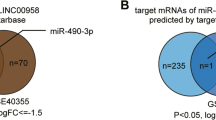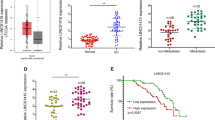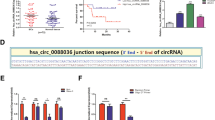Abstract
To investigate the influence of the long non-coding RNA LINC00312 on bladder cancer (BC) cell invasion and metastasis by targeting miR-197-3p. BC and corresponding adjacent tissues were collected. LINC00312 and miR-197-3p were measured, and their correlation was detected through quantitative real-time PCR (qRT-PCR). BC cell line T24 was transfected and grouped (five groups) according to different transfection conditions. A scratch test was applied to analyze cell migration, and a Transwell assay was used to test cell invasion ability. Western blotting was to measure matrix metalloproteinase (MMP)-2, MMP-9, and the tissue inhibitor of metalloproteinase 2 (TIMP2) protein levels. qRT-PCR indicated that LINC00312 expression was lower but miR-197-3p expression was higher in BC tissues compared with adjacent tissues; LINC00312 was negatively correlated with miR-197-3p. The migration test revealed that the downregulation of miR-197-3p and overexpression of LINC00312 inhibited cell migration and invasion abilities, while the overexpression of miR-197-3p and the upregulation of LINC00312 promoted cell migration and invasion. BC cells with downregulated miR-197-3p or upregulated LINC00312 had low MMP-2 and MMP-9 levels but high TIMP2. LINC00312 inhibited BC cell invasion and metastasis through mediating miR-197-3p.







Similar content being viewed by others
References
Bansal N, Gupta AK, Gupta A, Sankhwar SN, Mahdi AA. Serum-based protein biomarkers of bladder cancer: a pre- and post-operative evaluation. J Pharm Biomed Anal. 2016;124:22–5. doi:10.1016/j.jpba.2016.02.026.
Wang J, Zhang X, Wang L, Dong Z, Du L, Yang Y, et al. Downregulation of urinary cell-free microRNA-214 as a diagnostic and prognostic biomarker in bladder cancer. J Surg Oncol. 2015;111(8):992–9. doi:10.1002/jso.23937.
Torre LA, Bray F, Siegel RL, Ferlay J, Lortet-Tieulent J, Jemal A. Global cancer statistics, 2012. CA Cancer J Clin. 2015;65(2):87–108. doi:10.3322/caac.21262.
Lorenzatti Hiles G, Bucheit A, Rubin JR, Hayward A, Cates AL, Day KC, et al. ADAM15 is functionally associated with the metastatic progression of human bladder cancer. PLoS One. 2016;11(3):e0150138. doi:10.1371/journal.pone.0150138.
Jacobs BL, Lee CT, Montie JE. Bladder cancer in 2010: how far have we come? CA Cancer J Clin. 2010;60(4):244–72. doi:10.3322/caac.20077.
Amira AT, Mejri S, Belhaj R, Karkni W, Chebil M, Rammeh S. Prognostic value of Immunohistochemical expression profile of epidermal growth factor receptor in urothelial bladder cancer. J Immunoassay Immunochem. 2016. doi:10.1080/15321819.2016.1146757.
Griffiths TR. Action on bladder C. Current perspectives in bladder cancer management. Int J Clin Pract. 2013;67(5):435–48. doi:10.1111/ijcp.12075.
Yue B, Sun B, Liu C, Zhao S, Zhang D, Yu F, et al. Long non-coding RNA Fer-1-like protein 4 suppresses oncogenesis and exhibits prognostic value by associating with miR-106a-5p in colon cancer. Cancer Sci. 2015;106(10):1323–32. doi:10.1111/cas.12759.
Rinn JL, Chang HY. Genome regulation by long noncoding RNAs. Annu Rev Biochem. 2012;81:145–66. doi:10.1146/annurev-biochem-051410-092902.
Zhang W, Huang C, Gong Z, Zhao Y, Tang K, Li X, et al. Expression of LINC00312, a long intergenic non-coding RNA, is negatively correlated with tumor size but positively correlated with lymph node metastasis in nasopharyngeal carcinoma. J Mol Histol. 2013;44(5):545–54. doi:10.1007/s10735-013-9503-x.
Yu H, Xu Q, Liu F, Ye X, Wang J, Meng X. Identification and validation of long noncoding RNA biomarkers in human non-small-cell lung carcinomas. J Thorac Oncol. 2015;10(4):645–54. doi:10.1097/JTO.0000000000000470.
Fang YX, Chang YL, Gao WQ. MicroRNAs targeting prostate cancer stem cells. Exp Biol Med (Maywood). 2015;240(8):1071–8. doi:10.1177/1535370215584935.
Ninomiya M, Kondo Y, Funayama R, Nagashima T, Kogure T, Kakazu E, et al. Distinct microRNAs expression profile in primary biliary cirrhosis and evaluation of miR 505-3p and miR197-3p as novel biomarkers. PLoS One. 2013;8(6):e66086. doi:10.1371/journal.pone.0066086.
Yang Y, Li F, Saha MN, Abdi J, Qiu L, Chang H. miR-137 and miR-197 induce apoptosis and suppress tumorigenicity by targeting MCL-1 in multiple myeloma. Clin Cancer Res. 2015;21(10):2399–411. doi:10.1158/1078-0432.CCR-14-1437.
Sand M, Bechara FG, Gambichler T, Sand D, Friedlander MR, Bromba M, et al. Next-generation sequencing of the basal cell carcinoma miRNome and a description of novel microRNA candidates under neoadjuvant vismodegib therapy: an integrative molecular and surgical case study. Ann Oncol. 2016;27(2):332–8. doi:10.1093/annonc/mdv551.
Booton R, Lindsay MA. Emerging role of MicroRNAs and long noncoding RNAs in respiratory disease. Chest. 2014;146(1):193–204. doi:10.1378/chest.13-2736.
Gutschner T, Diederichs S. The hallmarks of cancer: a long non-coding RNA point of view. RNA Biol. 2012;9(6):703–19. doi:10.4161/rna.20481.
Matullo G, Naccarati A, Pardini B. MicroRNA expression profiling in bladder cancer: the challenge of next-generation sequencing in tissues and biofluids. Int J Cancer. 2016;138(10):2334–45. doi:10.1002/ijc.29895.
van Rhijn BW, Musquera M, Liu L, Vis AN, Zuiverloon TC, van Leenders GJ, et al. Molecular and clinical support for a four-tiered grading system for bladder cancer based on the WHO 1973 and 2004 classifications. Mod Pathol. 2015;28(5):695–705. doi:10.1038/modpathol.2014.154.
Sano T, Coit DG, Kim HH, Roviello F, Kassab P, Wittekind C, et al. Proposal of a new stage grouping of gastric cancer for TNM classification: international gastric cancer association staging project. Gastric Cancer. 2016. doi:10.1007/s10120-016-0601-9.
Roderburg C, Luedde T. Circulating microRNAs as markers of liver inflammation, fibrosis and cancer. J Hepatol. 2014;61(6):1434–7. doi:10.1016/j.jhep.2014.07.017.
Song MK, Choi HS, Lee HS, Kim YJ, Park YK, Ryu JC. Analysis of microRNA and mRNA expression profiles highlights alterations in modulation of the MAPK pathway under octanal exposure. Environ Toxicol Pharmacol. 2014;37(1):84–94. doi:10.1016/j.etap.2013.11.005.
Ebert MS, Sharp PA. Emerging roles for natural microRNA sponges. Curr Biol. 2010;20(19):R858–61. doi:10.1016/j.cub.2010.08.052.
Wang KC, Yang YW, Liu B, Sanyal A, Corces-Zimmerman R, Chen Y, et al. A long noncoding RNA maintains active chromatin to coordinate homeotic gene expression. Nature. 2011;472(7341):120–4. doi:10.1038/nature09819.
Cesana M, Cacchiarelli D, Legnini I, Santini T, Sthandier O, Chinappi M, et al. A long noncoding RNA controls muscle differentiation by functioning as a competing endogenous RNA. Cell. 2011;147(2):358–69. doi:10.1016/j.cell.2011.09.028.
Shi Y, Wang Y, Luan W, Wang P, Tao T, Zhang J, et al. Long non-coding RNA H19 promotes glioma cell invasion by deriving miR-675. PLoS One. 2014;9(1):e86295. doi:10.1371/journal.pone.0086295.
Yoon JH, Abdelmohsen K, Gorospe M. Functional interactions among microRNAs and long noncoding RNAs. Semin Cell Dev Biol. 2014;34:9–14. doi:10.1016/j.semcdb.2014.05.015.
Song H, Sun W, Ye G, Ding X, Liu Z, Zhang S, et al. Long non-coding RNA expression profile in human gastric cancer and its clinical significances. J Transl Med. 2013;11(225). doi:10.1186/1479-5876-11-225.
Nie Y, Liu X, Qu S, Song E, Zou H, Gong C. Long non-coding RNA HOTAIR is an independent prognostic marker for nasopharyngeal carcinoma progression and survival. Cancer Sci. 2013;104(4):458–64. doi:10.1111/cas.12092.
Zhang JG, Wang JJ, Zhao F, Liu Q, Jiang K, Yang GH. MicroRNA-21 (miR-21) represses tumor suppressor PTEN and promotes growth and invasion in non-small cell lung cancer (NSCLC. Clin Chim Acta. 2010;411(11–12):846–52. doi:10.1016/j.cca.2010.02.074.
Saito M, Schetter AJ, Mollerup S, Kohno T, Skaug V, Bowman ED, et al. The association of microRNA expression with prognosis and progression in early-stage, non-small cell lung adenocarcinoma: a retrospective analysis of three cohorts. Clin Cancer Res. 2011;17(7):1875–82. doi:10.1158/1078-0432.CCR-10-2961.
Wang KC, Chang HY. Molecular mechanisms of long noncoding RNAs. Mol Cell. 2011;43(6):904–14. doi:10.1016/j.molcel.2011.08.018.
Ma L, Reinhardt F, Pan E, Soutschek J, Bhat B, Marcusson EG, et al. Therapeutic silencing of miR-10b inhibits metastasis in a mouse mammary tumor model. Nat Biotechnol. 2010;28(4):341–7. doi:10.1038/nbt.1618.
Giza DE, Vasilescu C, Calin GA. Key principles of miRNA involvement in human diseases. Discoveries (Craiova). 2014;2(4):e34. doi:10.15190/d.2014.26.
Fan M, Li X, Jiang W, Huang Y, Li J, Wang ZA. Long non-coding RNA, PTCSC3, as a tumor suppressor and a target of miRNAs in thyroid cancer cells. Exp Ther Med. 2013;5(4):1143–6. doi:10.3892/etm.2013.933.
Tang L, Zhang W, Su B, Long YB. Noncoding RNA HOTAIR is associated with motility, invasion, and metastatic potential of metastatic melanoma. Biomed Res Int. 2013. doi:10.1155/2013/251098.
Sun M, Liu XH, Wang KM, Nie FQ, Kong R, Yang JS, et al. Downregulation of BRAF activated non-coding RNA is associated with poor prognosis for non-small cell lung cancer and promotes metastasis by affecting epithelial-mesenchymal transition. Mol Cancer. 2014;13(68). doi:10.1186/1476-4598-13-68.
TY W, Zhang TH, LM Q, Feng JP, Tian LL, Zhang BH, et al. MiR-19a is correlated with prognosis and apoptosis of laryngeal squamous cell carcinoma by regulating TIMP-2 expression. Int J Clin Exp Pathol. 2014;7(1):56–63.
Yan A, Yang C, Chen Z, Li C, Cai L. MiR-761 promotes progression and metastasis of non-small cell lung cancer by targeting ING4 and TIMP2. Cell Physiol Biochem. 2015;37(1):55–66. doi:10.1159/000430333.
Filkova M, Aradi B, Senolt L, Ospelt C, Vettori S, Mann H, et al. Association of circulating miR-223 and miR-16 with disease activity in patients with early rheumatoid arthritis. Ann Rheum Dis. 2014;73(10):1898–904. doi:10.1136/annrheumdis-2012-202815.
Acknowledgments
This study was supported by the Jiangsu Planned Projects for Postdoctoral Research Fund (1501142B). We would like to give our sincere appreciation to the reviewers for their helpful comments on this article.
Author information
Authors and Affiliations
Corresponding author
Ethics declarations
Conflicts of interest
None
Additional information
Yun-Yan Wang, Zi-Yu Wu, and Gong-Cheng Wang are regarded as co-first authors.
Rights and permissions
About this article
Cite this article
Wang, YY., Wu, ZY., Wang, GC. et al. LINC00312 inhibits the migration and invasion of bladder cancer cells by targeting miR-197-3p. Tumor Biol. 37, 14553–14563 (2016). https://doi.org/10.1007/s13277-016-5303-8
Received:
Accepted:
Published:
Issue Date:
DOI: https://doi.org/10.1007/s13277-016-5303-8




